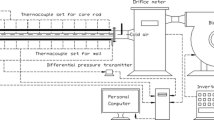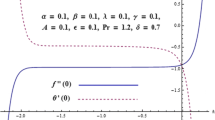Abstract
Heat and mass transfer in a circular tube subject to the boundary condition of the third kind is investigated. The closed form of temperature and concentration distributions, the local Nusselt number based on the total external heat transfer and convective heat transfer inside the tube, as well as the Sherwood number were obtained. The effects of Lewis number and Biot number on heat and mass transfer were investigated.











Similar content being viewed by others
Abbreviations
- A :
-
constant in Eq. 4
- A m :
-
coefficient in Eq. 38
- B :
-
constant in Eq. 4
- B m :
-
coefficient in Eq. 39
- Bi :
-
Biot number
- C :
-
mass fraction (dimensionless)
- C 1 :
-
constant in Eq. 29
- C 2 :
-
constant in Eq. 30
- c p :
-
specific heat at constant pressure (J/kg K)
- D :
-
mass diffusivity (m2/s)
- F 1 :
-
unspecified constant in Eq. 24
- F 2 :
-
unspecified constant in Eq. 31
- h :
-
heat transfer coefficient (W/m2 K)
- h sg :
-
latent heat of sublimation (J/kg)
- J 0 :
-
Bessel function of zero order
- J 1 :
-
Bessel function of first order
- k :
-
thermal conductivity (W/m K)
- L :
-
dimensionless latent heat defined by Eq. 5
- Lew:
-
Lewis number
- Nu e :
-
Nusselt number based on the heat transfer of external flow
- Nu i :
-
Nusselt number based on the heat transfer of the internal tube flow
- Pe :
-
Peclet number
- R :
-
radius of the tube (m)
- Re :
-
Reynolds number
- r :
-
radius coordinate
- Sh :
-
Sherwood number
- T :
-
temperature (K)
- U :
-
fluid velocity (m/s)
- u :
-
fluid velocity (m/s)
- X :
-
dimensionless axial coordinate
- x :
-
axial coordinate
- W :
-
eigen function
- α :
-
thermal diffusivity (m2/s)
- β :
-
eigenvalue
- φ :
-
dimensionless concentration
- η :
-
dimensionless radial coordinate
- λ :
-
eigenvalue
- θ :
-
dimensionless temperature
- ρ :
-
density (kg/m3)
- o:
-
entrance
- e:
-
external
- i:
-
internal
- m:
-
mean value control variable
- w:
-
wall
References
Kuu WY, Hardwick LM, Akers MJ (2006) Rapid determination of dry layer mass transfer resistance for various pharmaceutical formulations during primary drying using product temperature profiles. Int J Pharm 313:99–113
Hottot A, Peczalski R, Vessot S, Andrieu J (2006) Freeze-drying of pharmaceutical proteins in vials: modeling of freezing and sublimation steps. Drying Technol 24:561–570
Millman MJ, Liapis AI, Marchello JM (1985) An analysis of the lyophilization process using a sorption-sublimation model and various operational policies. AIChE J 31:1594–1604
Dyer DF, Sunderland JE (1968) Heat and mass transfer mechanism in sublimation dehydration. J Heat Transfer 90:379–384
Khalloufi S, Robert J-L, Ratti C (2005) Solid foods freeze-drying simulation and experimental data. J Food Process Eng 28:107–132
Mellor JD (1978) Fundamentals of freeze drying. Academic Press Inc., London
Jiao AJ, Han X, Critser JK, Ma HB (2006) Numerical investigations of transient heat transfer characteristics and vitrification tendencies in ultra-fast cell cooling processes. Cryobiology 52:386–392
Boutron P (1986) Comparison with the theory of the kinetics and extent of ice crystallization and of the glass-forming tendency in aqueous cryoprotective solutions. Cryobiology 23:88–102
Faghri A, Zhang Y (2006) Transport phenomena in multiphase systems. Elsevier, Burlington
Sparrow EM, Spalding EC (1968) Coupled laminar heat transfer and sublimation mass transfer in a duct. ASME J Heat Transf 90:115–125
Sparrow EM, Chen TS (1969) Mutually dependent heat and mass transfer in laminar duct flow. J AIChE 3:343–441
Kurosaki Y (1973) Coupled heat and mass transfer in a flow between parallel flat plate (uniform heat flux). Trans JSME 39 part B:2512–2521
Zhang Y, Chen Z (1992) Analytical solution of coupled laminar heat-mass transfer in a tube with uniform heat flux. J Therm Sci 1:184–188
Zhang Y (2002) Coupled forced convection heat and mass transfer in a circular tube with external convective heating. Prog Comput Fluid Dyn 2:90–96
Author information
Authors and Affiliations
Corresponding author
Appendix
Appendix
The general solution of equation θ (Eq. 6) can be obtained by separation of variables [14]
where, F 1 is an unspecified constant and β is the eigenvalue.
By using separation of variables method, the solution of φ can be written as
Substituting Eq. 25 into Eq. 7, we have
where λ is the eigenvalue. Equation 26 can be rewritten as
The general solution of Eq. 27 is
Equation 28 is a zeroth order of Bessel equation, based on the boundary condition specified by Eq. 9, its solution can be expressed as
Therefore, the dimensionless concentration solution becomes
where, F 2 is another unspecified constant.
Substituting Eqs. 24 and 31 into Eqs. 10 and 11, one obtains
Obviously, F 1 = F 2 when Lew = 1, thus,
When \( {\text{Lew}} \ne 1, \) Eq. 34 should be replaced by
There will be many different eigenvalues which satisfy Eqs. 34 or 35, thus, eigenvalues β m (m = 1, 2, 3,…) obtained by the eigen equations can be expressed by
Thus, θ and φ can be written as
and
The equation should satisfy the boundary conditions of Eq. 8, i.e.,
Thus,
Similarly:
Therefore, Eqs. 38 and 39 can be rewritten as
Rights and permissions
About this article
Cite this article
Jiao, A., Zhang, Y., Ma, H. et al. Effects of Lewis number on coupled heat and mass transfer in a circular tube subjected to external convective heating. Heat Mass Transfer 45, 591–598 (2009). https://doi.org/10.1007/s00231-008-0463-8
Received:
Accepted:
Published:
Issue Date:
DOI: https://doi.org/10.1007/s00231-008-0463-8




